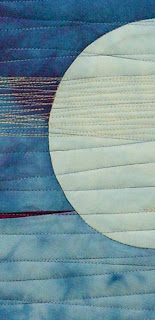 |
| The Ultimate Sashiko Sourcebook by Susan Briscoe |
My google search also lead me to the Sashiko technique. In Susan Briscoe’s book she explains that Sashiko stitching was not only a way to decorate fabric but was also used on Indigo dyed workmens’ clothes to make the fabric more sturdy at places that were likely to be worn sooner.
Susan also referred to Boro, Japanese (rag) textiles and then I discovered this website.
Boro was made in the 19th century by recycling remnants of indigo dyed cotton and joining them together. I had seen some beautiful pieces of new made Boro by Victoria of the SillyBooDilly. Victoria’s work is always an inspiration.
Blue jeans (the word jeans comes from Genoa, Italy - more about that later...!) was also used as workmens’ clothes. They discovered archeological ‘jeans’ pieces in the gold mines in California, likely to be about a 150 years old, which look really worn and weathered. These old jeans as well as the old Boro textiles have become collector’s items now.
I may have found the ingredients for my Blue quilt!
Nicolette
 |
| David Sorgato’s book about Boro |
Boro was made in the 19th century by recycling remnants of indigo dyed cotton and joining them together. I had seen some beautiful pieces of new made Boro by Victoria of the SillyBooDilly. Victoria’s work is always an inspiration.
Blue jeans (the word jeans comes from Genoa, Italy - more about that later...!) was also used as workmens’ clothes. They discovered archeological ‘jeans’ pieces in the gold mines in California, likely to be about a 150 years old, which look really worn and weathered. These old jeans as well as the old Boro textiles have become collector’s items now.
I may have found the ingredients for my Blue quilt!
Nicolette












